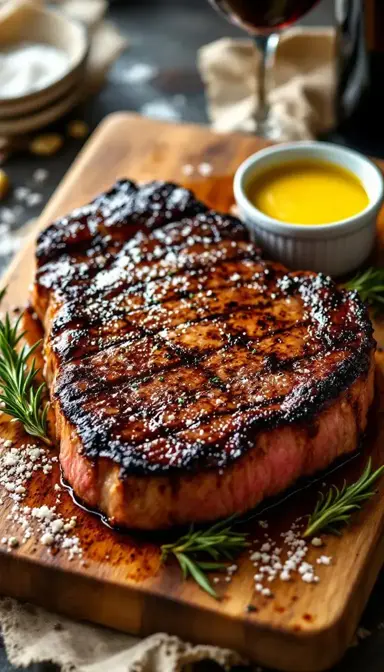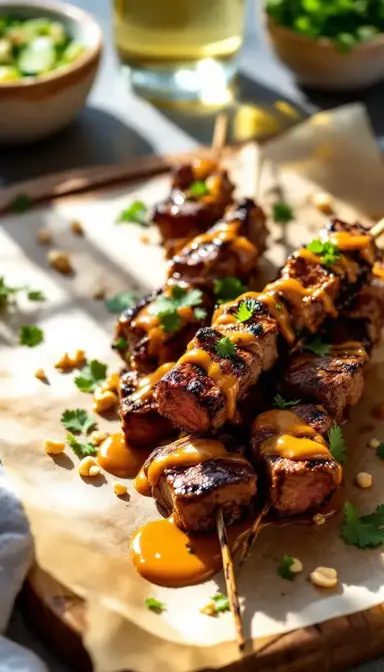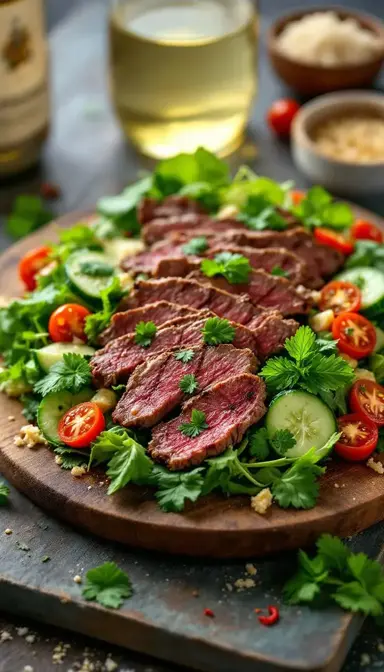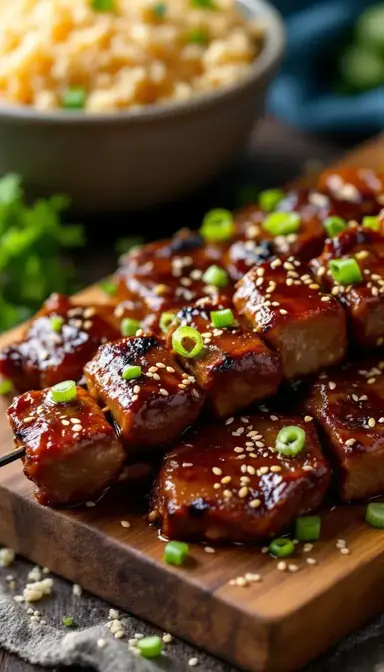There’s something almost magical about cutting into a perfectly cooked steak—the way the knife glides through, revealing a rosy interior that promises tenderness in every bite. But here’s the truth: most home cooks get it wrong. They throw a cold steak onto a screaming hot pan, hoping for the best, only to end up with a gray band of overcooked meat surrounding a tiny pink center.
That’s why I’m obsessed with the reverse sear method. It’s the steakhouse secret that guarantees edge-to-edge perfection every single time. Imagine this: a NY strip so tender it practically melts on your tongue, with a crust so flavorful you’ll be scraping the plate for every last crispy bit. That’s what we’re making today.
Why This Recipe Works
Let me tell you about the first time I tried reverse-searing. I was skeptical—roasting a steak low and slow before searing? It felt backwards. But one bite changed everything. The difference is night and day:
- No more guesswork: That sad dance of cutting into your steak to check doneness? Gone. With a thermometer, you hit the exact temp you want.
- Juice stays where it belongs: Slow cooking lets the muscle fibers relax gently, so they hold onto moisture instead of squeezing it all out onto your plate.
- Crust that puts restaurants to shame: Dry-brining creates a surface so perfect for searing, you’ll get that crackly, caramelized exterior every time.
Essential Ingredients & Tools
Ingredients for the Steak
- 1 (1.5–2-inch thick) NY strip steak (thickness ensures even cooking; ribeye or filet mignon can substitute).
- 1 tbsp kosher salt (draws out moisture for a deeper crust; sea salt works but adjust quantity).
- 1 tsp freshly ground black pepper (adds aromatic spice; white pepper for milder heat).
- 1 tbsp high-smoke-point oil (avocado or grapeseed oil for searing without burning; vegetable oil works in a pinch).
- 2 tbsp unsalted butter (optional, for basting; adds richness and gloss).
- 2 garlic cloves, crushed (optional, for infused aroma; omit if preferred).
- 2 sprigs fresh thyme or rosemary (optional, herbal depth; dried herbs are less ideal).
Tools You’ll Need
- Wire rack + baking sheet (elevates steak for even air circulation during roasting; a cooling rack over a rimmed pan works).
- Instant-read thermometer (critical for monitoring internal temperature; a basic digital one is fine).
- Cast-iron skillet or heavy stainless steel pan (retains heat for a perfect sear; any heavy-bottomed pan will do).
- Tongs (avoids piercing the steak, preserving juices; forks can substitute in a pinch).
- Aluminum foil (for resting the steak post-sear).
Serves: 1–2 | Prep time: 5 mins (plus 1–24 hrs dry-brining) | Cook time: 30–45 mins | Total time: 35–50 mins
How to Make Reverse-Seared NY Strip Steak
1. Dry-Brine Like a Pro
Pat your steak dry—really dry. Moisture is the enemy of a good crust. Generously coat all sides with 1 tbsp kosher salt (about 1 tablespoon for a 1.5-inch steak). Place it on a wire rack over a baking sheet and refrigerate uncovered for at least 1 hour, up to 24.
Why this works: The salt draws out moisture, which then dissolves the salt and gets reabsorbed, seasoning the meat from the inside out. The uncovered fridge time dries the surface, which means better browning later.
2. Slow Roast to Tender Perfection
Preheat your oven to 275°F. Let the steak sit at room temp for 20-30 minutes (even cooking starts here). Roast on the wire rack until the internal temp hits:
- 110°F for rare (think “still cool center”)
- 125°F for medium-rare (warm red center)
This usually takes 20-35 minutes depending on thickness. The low heat gently brings the whole steak up to temp without overcooking the edges.
3. The Sizzling Finale
About 10 minutes before the steak finishes roasting, heat your cast-iron skillet over high heat until it’s smoking hot. Add 1 tbsp high-smoke-point oil. Pat the steak dry again (critical for crust), then lay it in the pan.
Sear for 1-2 minutes per side. For extra flavor, add 2 tbsp unsalted butter, 2 crushed garlic cloves, and 2 sprigs fresh thyme or rosemary in the last 30 seconds, tilting the pan to baste the steak continuously. The smell at this point is intoxicating.
4. The Patience Payoff
Transfer the steak to a plate, tent loosely with foil, and let it rest for 10 minutes. I know, waiting is hard—but this lets the juices redistribute. Skip it, and you’ll have a dry steak.
Slice against the grain (look for the lines of muscle fibers) for maximum tenderness.
Pro Technique
The Dry-Brine Deep Dive
That uncovered fridge time isn’t just about drying—it’s flavor alchemy. The salt penetrates deep, breaking down tough proteins for a buttery texture. For best results, go for at least 12 hours if you can.
Searing Secrets
Your pan should be so hot it scares you. Test it by flicking a few drops of water—if they dance and evaporate instantly, you’re ready. And never crowd the pan; sear one steak at a time to maintain that blistering heat.
Thickness Matters
A 1.5-inch steak is the sweet spot. Too thin, and it overcooks before the center is done. Too thick, and the oven time gets excessive. If you must go thinner, reduce oven time by 5-10 minutes.
Perfect Pairings
Complementary Dishes
- Crispy Roasted Potatoes: Golden and crunchy, they mirror the steak’s texture while soaking up juices. Toss with olive oil if duck fat isn’t handy.
- Creamed Spinach: The creamy, earthy notes balance the steak’s boldness. Add a pinch of nutmeg for depth.
Drinks
- Cabernet Sauvignon: The tannins cut through the fat beautifully. A budget-friendly Malbec works too.
- Smoky Bourbon: Sip it neat to complement the charred crust. A peaty Scotch is a bolder alternative.
Something Sweet
- Dark Chocolate Tart: Bittersweet chocolate contrasts the steak’s umami.
- Grilled Peaches: Caramelized fruit lightens the meal. Serve with a dollop of Whipped Cream.
Storage & Freshness Guide
If by some miracle you have leftovers:
- Store in an airtight container for 3-4 days.
- Reheat gently in a 250°F oven or briefly in a skillet with butter.
- Never, ever microwave—it turns steak into shoe leather.
Chef’s Wisdom
Reverse-searing isn’t just another cooking method—it’s a revelation. Once you taste that perfectly even doneness, that crust that shatters under your knife, you’ll never go back to the old way. It’s the difference between a good steak and a “close your eyes and savor every bite” steak.
So grab that thick NY strip, fire up your oven, and get ready to experience steak like never before. Your taste buds will thank you.

The Reverse-Seared NY Strip Steak: A Buttery, Juicy Masterpiece You Can Make at Home
Master the Reverse-Seared NY Strip Steak with my foolproof method for edge-to-edge perfection. Juicy, tender, and packed with flavor—get the recipe now!
Ingredients
For the Steak
-
1 NY strip steak (1.5–2-inch thick)
-
1 tbsp kosher salt
-
1 tsp freshly ground black pepper
-
1 tbsp high-smoke-point oil
-
2 tbsp unsalted butter (optional)
-
2 garlic cloves (crushed, optional)
-
2 sprigs fresh thyme or rosemary (optional)
Instructions
-
Pat steak dry and coat with 1 tbsp kosher salt. Refrigerate uncovered on a wire rack for 1–24 hours.01
-
Preheat oven to 275°F. Let steak sit at room temp for 20–30 mins.02
-
Roast on wire rack until internal temp reaches 110°F (rare) or 125°F (medium-rare).03
-
Heat skillet over high heat. Pat steak dry, sear 1–2 mins per side. Baste with 2 tbsp unsalted butter, 2 crushed garlic cloves, and 2 sprigs fresh thyme or rosemary if using.04
-
Rest 10 mins before slicing against the grain.05



